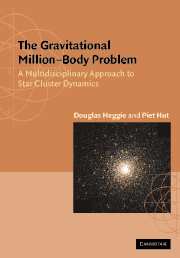Book contents
- Frontmatter
- Contents
- Preface
- PART I INTRODUCTIONS
- PART II THE CONTINUUM LIMIT: N → ∞
- 5 Paradoxical Thermodynamics
- 6 Statistical Mechanics
- 7 Motion in a Central Potential
- 8 Some Equilibrium Models
- 9 Methods
- PART III MEAN FIELD DYNAMICS: N = 106
- PART IV MICROPHYSICS: N = 2
- PART V GRAVOTHERMODYNAMICS: N = 106
- PART VI GRAVITATIONAL SCATTERING: N = 3
- PART VII PRIMORDIAL BINARIES: N = 4
- PART VIII POST-COLLAPSE EVOLUTION: N = 106
- PART IX STAR CLUSTER ECOLOGY
- Appendix A A Simple N-Body Integrator
- Appendix B Hints to Solution of Problems
- References
- Index
8 - Some Equilibrium Models
Published online by Cambridge University Press: 05 June 2012
- Frontmatter
- Contents
- Preface
- PART I INTRODUCTIONS
- PART II THE CONTINUUM LIMIT: N → ∞
- 5 Paradoxical Thermodynamics
- 6 Statistical Mechanics
- 7 Motion in a Central Potential
- 8 Some Equilibrium Models
- 9 Methods
- PART III MEAN FIELD DYNAMICS: N = 106
- PART IV MICROPHYSICS: N = 2
- PART V GRAVOTHERMODYNAMICS: N = 106
- PART VI GRAVITATIONAL SCATTERING: N = 3
- PART VII PRIMORDIAL BINARIES: N = 4
- PART VIII POST-COLLAPSE EVOLUTION: N = 106
- PART IX STAR CLUSTER ECOLOGY
- Appendix A A Simple N-Body Integrator
- Appendix B Hints to Solution of Problems
- References
- Index
Summary
In Chapter 6 we spent some time discussing the statistical description of an N-body system in terms of its one-particle distribution function, f. We also introduced an evolution equation for f, the ‘collisionless’ Boltzmann equation. We did not, however, dwell on any solutions of this equation, except to characterise them in terms of Jeans' Theorem. In fact equilibrium solutions have been known and studied for about 100 years, and they are of enduring importance.
The specific choice of f may be made for a variety of reasons. Plummer's model, for instance, is often used for starting a numerical calculation, because of its analytical convenience. The isothermal model is of importance in the study of thermodynamic stability (Chapter 17), while King's model has taken centre stage for many years in the interpretation of observations. Another approach to this particular topic, also based on the phase-space description, deserves a section on its own at the end of the chapter.
By Jeans' Theorem, f is a collisionless equilibrium solution if (but not only if) it depends on the energy, E. Most of the models we mention are of this kind. In what follows we shall usually characterise a model by its distribution function f (E), but that is only part of the story, because f depends on the potential φ (via E), and we need to know how φ depends on the position in space r in order to determine f at any point in phase space.
- Type
- Chapter
- Information
- The Gravitational Million–Body ProblemA Multidisciplinary Approach to Star Cluster Dynamics, pp. 68 - 77Publisher: Cambridge University PressPrint publication year: 2003



